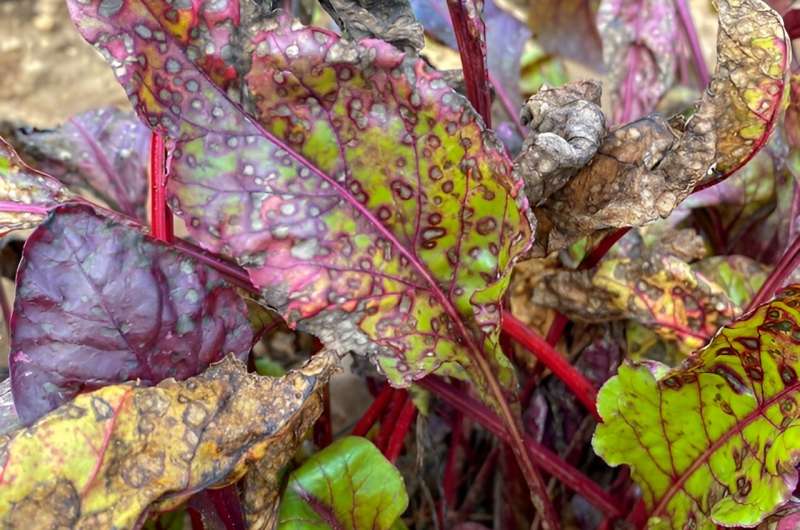This article has been reviewed according to Science X's editorial process and policies. Editors have highlighted the following attributes while ensuring the content's credibility:
fact-checked
trusted source
proofread
UV light treats beet disease and combats fungicide resistance

Germicidal ultraviolet light is effective at killing a damaging fungus that infects table beets, adding an important organic tool to fight the growing problem of fungicide resistance, according to a new Cornell study.
While UV light is already used to fight powdery and downy mildew in grapes, powdery mildew in strawberries, and a contagious bacteria that causes fire blight in apples, pears, and members of the family Rosaceae, this is the first proof that the germicidal light can work in a vegetable.
Fire blight and powdery and downy mildew live on the outside of leaves and shoots, but this study shows UV light suppresses Cercospora leaf spot fungus, which has part of its lifecycle inside the plant.
"Cercospora leaf spot infects the leaf and causes defoliation, and therefore, because table beets are harvested with what's called top-pulling machinery—machines that grab the roots and pull the roots out of the ground—when the leaves are gone, they don't work," said Sarah Pethybridge, associate professor of plant pathology and plant-microbe biology at Cornell AgriTech and corresponding author of a study published in Plant Disease.
Now, the researchers can take the next steps: using drone or satellite imagery to identify spectral signatures of the disease in beet fields in order to spot-treat infected plants with UV light at night rather than treating an entire field, which isn't feasible. They are also investigating the use of automated robotic vehicles that could position a wagon fitted with UV lights to shine on infected plants.
More work is needed to know whether this technology will be applicable to other vegetable diseases and crops. "It depends upon the sensitivity of the pathogen to UV light, but also the sensitivity of the particular vegetable, so it has to be trialed on a case-by-case basis," Pethybridge said.
There are three types of UV light: UVA has the longest wavelengths, followed by UVB, and then UVC, with the shortest wavelengths; the latter is used to treat plant diseases. When exposed to UV light during the day, fungal pathogens have a mechanism that repairs damage to DNA, but when UVC is applied at night, that mechanism can't repair the damage, which permanently compromises DNA replication in fungal spores.
One caveat is that the treatment is most effective when it is followed by four hours of darkness before sunrise, so applications are recommended right after sundown.
In the study, the researchers tested UVC light directly on Cercospora leaf spot fungal spores in the lab. Once proven that it worked, and after determining doses, they tested it on beet plants in the greenhouse. They found that UVC light at effective doses created some toxicity to the plants, but they grew out of it. They also found that older plants were more susceptible to damage than younger plants.
Pethybridge and colleagues then conducted two years of field trials in New York state—the No. 1 beet-growing state in the country—where they identified an optimal dose to suppress the fungus while causing minimal toxicity to plants.
The new tool will greatly help against fungicide resistance in Cercospora leaf spot, which is genetically diverse and can rapidly overcome conventional fungicides, which must be frequently applied. UVC light treatments may be used in the traditional production of beet as well as in organic systems, where synthetic fungicides are not permitted.
Project collaborators included Love Beets, which makes organic beet products, and Seneca Foods, known for conventional products, both major beet producers in New York. The companies provided support letters for funding, helped identify farmers for trials, and served on a stakeholder advisory panel, which met every six months to provide feedback on the project.
More information: Sarah Jane Pethybridge et al, Nighttime Applications of Germicidal Ultraviolet Light (UV-C) to Suppress Cercospora Leaf Spot in Table Beet, Plant Disease (2024). DOI: 10.1094/PDIS-12-23-2715-RE
Provided by Cornell University





















